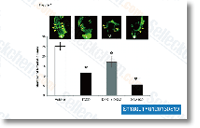A even more consideration considerations the proof the latest data from seven day treated SNI rats don’t seem to be constant with information obtained in sufferers suffering from neuropathic pain, in whom atrophy in the limbic prefrontal cortex was reported, Having said that, as pre viously recommended by Metz et al, it is achievable that this neuropathic soreness model and the brief time period of observation did not allow us to note any obvious neurodegeneration. Without a doubt there may be no reason to exclude the likelihood that following a longer time period of above excitation, elevated spine variety and NMDA receptor currents may possibly cause greater glutamatergic excitotoxi city and apoptosis.
Based mostly to the more than expressed endocannabinoid endova nilloid biomarkers and elevated glutamate amounts, we determined to perform in SNI rats a repeated daily NSC 74859 molecular weight systemic treatment method with AA 5 HT, which we had previously demonstrated to produce anti allodynic and anti hyperalgesic results in the persistent constriction injury neuropathic soreness model by means of each indirect activa tion desensitization of TRPV1 and activation of cannabi noid CB1 receptors, following elevation of AEA and 2 AG ranges, and direct TRPV1 receptor antagonism, Without a doubt, AA five HT exerts its analgesic impact in 3 approaches. i antagonism of TRPV1 receptors concerned in thermal hyperalgesia, ii desensitization of TRPV1 expressing nociceptors involved in mechanical allody nia and iii indirect agonism at cannabinoid CB1 receptors in the CCI model of neuropathic soreness, Right here we report that AA 5 HT treatment was capable to prevent mechanical allodynia and modulate each inhi bitory and excitatory transmission while in the BLA mPFC pathway.
Intriguingly, the relative efficacy on the results of intra PL IL cortex microinjections of selective vanil loid or FAAH inhibitors or with the hybrid compound, AA 5 HT, underline the impor tance of concentrating two actions in a single single molecule to drastically Ostarine cut down allodynia and even more validate the vital position played by TRPV1 and FAAH in specific mPFC sub regions concerned in ache modula tion.
Numerous previous studies have reported that the PL IL cortex, which corresponds towards the dorsal lateral prefrontal cortex in humans, plays a crucial purpose in pain processing, and emerging imaging stu dies present  that this brain area is concerned in pain inhibition in humans Moreover, since the remedy with AA five HT led to restore usual neuronal action in the BLA mPFC pathway, these data assistance our hypothesis that the over expressed TRPV1 channel, which seems to be mostly present in glutamatergic neurons, is among the mechanisms that in SNI rats activate pathways associated with cell plasticity, In agreement together with the TRPV1 induced neural plasticity described previously, it’s doable that practical re organization mediated by glutamate endovanilloid and GABA endocannabinoid signalling may also come about following TRPV1 channel more than stimula tion as well as consequent increased release of glutamate while in the PL IL cortex of SNI rats in both identified popu lations of mPFC neurons.
that this brain area is concerned in pain inhibition in humans Moreover, since the remedy with AA five HT led to restore usual neuronal action in the BLA mPFC pathway, these data assistance our hypothesis that the over expressed TRPV1 channel, which seems to be mostly present in glutamatergic neurons, is among the mechanisms that in SNI rats activate pathways associated with cell plasticity, In agreement together with the TRPV1 induced neural plasticity described previously, it’s doable that practical re organization mediated by glutamate endovanilloid and GABA endocannabinoid signalling may also come about following TRPV1 channel more than stimula tion as well as consequent increased release of glutamate while in the PL IL cortex of SNI rats in both identified popu lations of mPFC neurons.
Mirna Array
Fast, easy and accurate miRNA profiling using mirna array
